Uncategorised
dynaBunion 4D Bunion Procedure

dynaBunion® is 4D Dy-Na-Mite!
The dynaBunion® Lapidus system gives surgeons the instruments and implants to correct bunions in 4 dimensions (4D) through a minimal-incision. A traditional Lapidus surgery requires surgeons to make a large incision and manually hold several small bones in 4D simultaneously while trying to attach a surgical plate. Frequently, surgeons wish for an “extra set of hands”.
The dynaBunion® instruments act like an extra set of hands to drastically reduce the frustration of maintaining 4D alignment while performing a Lapidus procedure. This gives the surgeon the freedom to optimize the alignment and create a more accurate bunion correction.
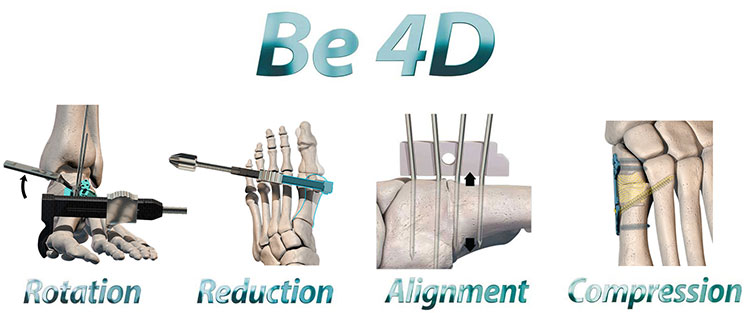
Optimize Healing and Preserve Toe Length
With the OsteoPrecise™ cut guide, surgeons are able to remove a minimal amount of bone. This preserves good bone and potentially optimizes healing and maintains the length of the toe. If the big toe gets shortened due too much bone removal, it can alter the function of the foot and cause lifelong pain.
Activate the 4th Dimension
The 4th Dimension of the Lapidus procedure is compression. The dynaBunion® system delivers compression through our proprietary instrumentation and patented DynaForce® Staple Compression Plates™. This compression holds the bones together during and after surgery to potentially accelerate fusion healing, which gives the patient the opportunity for a walking recovery and a faster return to activity.
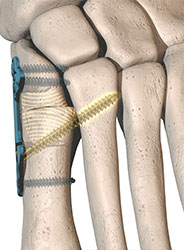

One and Done Bunion Correction
Approximately 12% of Lapidus patients have their bunion reoccur because the toe “drifts” back into an unnatural position1. The dynaBunion® Anti-Drift Bolt™ provides 480% more resistance2 to drift forces which significantly reduces the likelihood of the bunion returning. Since recurrence usually means another surgery, it is a major source of frustration for patients and surgeons alike. The addition of the Anti-Drift Bolt™ helps minimize recurrence.
The dynaBunion 4D Bunion Procedure patient education brochure
Lapiplasty
Bunions are complex deformities that can be very painful. James Kutchback, DPM is pleased to offer a new, patented treatment for bunion correction—Lapiplasty® 3D Bunion Correction. At our clinic Dr. Litherland is trained and have experience with this procedure.
What is Lapiplasty® 3D Bunion Correction?
Lapiplasty® 3D Bunion Correction is an advanced surgical procedure that corrects a bunion by rotating the entire deviated bone back into its normal anatomical position. This is done using specially-designed instrumentation, naturally straightening your toe and removing the “bump” and associated pain. Innovative plating technology is used to permanently secure the unstable joint. Most patients are able to walk within days of surgery. No cast is required; allowing patients to get back to the shoe wear of their choice and activities quickly.
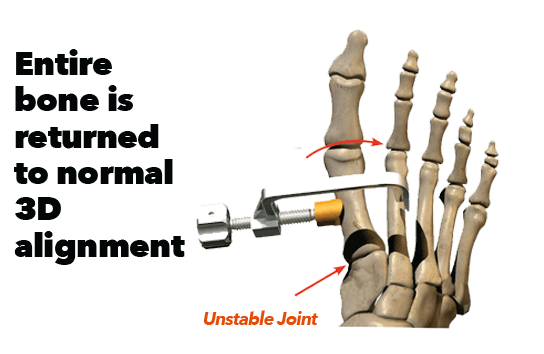
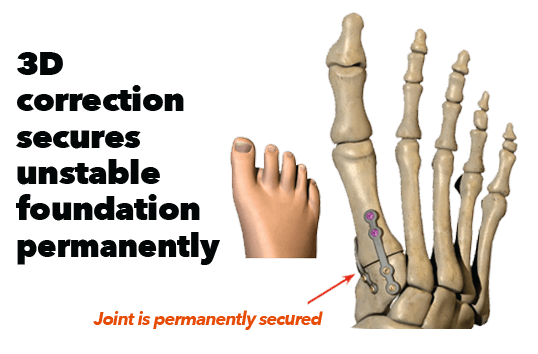
Lapiplasty® Patented Titanium
The Lapiplasty® Procedure utilizes two low-profile (petite), anatomically-shaped titanium plates to permanently secure the unstable foundation of your corrected bunion. This provides buttressing on multiple planes and allows you to walk within days of surgery. Think of this in terms of how a basketball player might hold a basketball. When a player tightly grips the ball with both hands, the ball is held more securely than if only one hand is used.
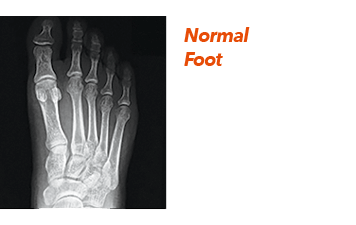
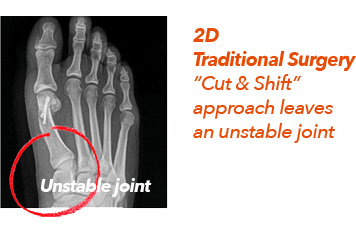
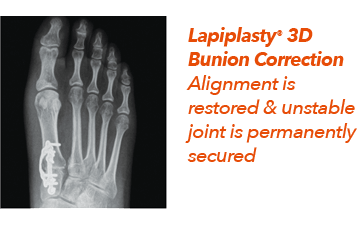
What Should I Expect In Terms Of Recovery?
The patented titanium plating technology used with the Lapiplasty® Procedure enables patients to bear weight on their foot early. The ability to do so can dramatically improve your recovery process, allowing you to walk up to 6-8 weeks earlier than with the more traditional Lapidus approach (which was previously the only option for addressing the unstable joint).
Being able to walk in a surgical boot, as opposed to being completely non-weight bearing (in a cast with scooter or crutches) for 6-8 weeks, means that you will be getting back to a better quality of life faster; may return to most occupations more quickly; and will be less inconvenienced by bunion surgery.
Frequently Asked Questions
Below are some questions patients commonly ask and their respective answers:
How long does it take to recover from a Lapiplasty® Procedure?
Patients are typically walking within days of surgery. Patients can return to most occupations within days to a couple of weeks, wearing a surgical boot. Within six weeks, you can expect to be walking in comfortable shoes such as tennis shoes, however you should not plan on any high-impact activities for 3-4 months. Short shopping trips and leisurely strolls are examples of the types of activities that should be fine at this point. Around the 4-month mark post-op, you should be able to return to most activities and most shoe wear.
Can I wear fashionable shoes again?
The Lapiplasty® Procedure allows most patients to return to their desired shoes. Of course, some fashionable shoes can be painful (even with a normal foot!), so results can vary from person to person and shoe to shoe.
Can I play sports after the Lapiplasty® Procedure?
Yes, there are no permanent activity limitations after the Lapiplasty® Procedure. Most patients are able to return to most activities after the bones have completely healed at approximately 4 months.
Can the Lapiplasty® Procedure be performed on someone who has previously had traditional surgery?
Yes, the Lapiplasty® Procedure is an option that can be utilized by your doctor when a revision is required. Even if previously treated, patients can experience the same benefits from Lapiplasty® – with a permanently secured foundational joint this time around.
I’ve heard the term “reproducible” used when describing the Lapiplasty® Procedure. What does that mean?
“Reproducible” means that a procedure is easily repeatable with expected results. The Lapiplasty® Procedure utilizes precision, patented instrumentation designed to take the guesswork and “eyeballing” out of bunion surgery; helping ensure your surgeon can get reliable results over and over.
Can the Lapiplasty® Procedure be performed as an outpatient procedure & how long does it last?
Yes, Lapiplasty® surgeries are performed as outpatient procedures. Typically, the surgery will last just under an hour. If your doctor is performing any additional procedures at the same time, the surgery may take longer.
The Lapiplasty Procedure patient education brochure
 Lapiplasty® 3D Bunion Correction Brochure
Lapiplasty® 3D Bunion Correction Brochure
Remy Laser Therapy for Toenail Fungus
Are You Suffering and/or Embarrassed from Toenail Fungus?
Choose Laser Therapy From
James Kutchback, DPM, CWS-P
You no longer need to feel embarrassed to wear open-toe shoes and sandals - or just go barefoot - because of toenail fungus or discoloration. James Kutchback, DPM, CWS-P is the area’s leader in restoring nails back to health, providing a natural and luminous appearance.
Class IV laser therapy is one of the most safe and effective ways to treat toenail fungus (onychomycosis)!
Laser therapy penetrates the nail bed and kills the fungus living underneath the nail - without pain and without any harmful side effects.
When the colony of fungus under the nail is “attacked” by the laser, the elements that make it grow and thrive are destroyed. This allows your nail bed to begin growing new, healthy nail. Nails that won’t give you feelings of discomfort or embarrassment!
Laser therapy is a quick and easy treatment allowing patients to relax during the procedure.
SCHEDULE A LASER CONSULTATION ATJAMES KUTCHBACK, DPM, CWS-P NOW
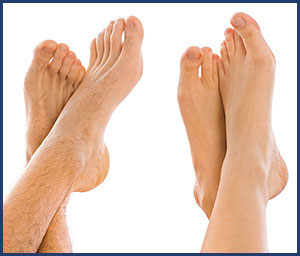
What is Onychomycosis?
Fungal foot infections. They can create major discomfort and even embarrassment. They are also EXTREMELY COMMON; affecting millions of people each year.
Additionally, fungus is easily spread. Individuals with fungus may have contracted it through shared bathroom space, public locker rooms, showers, and pools, shared clothing or shoes, even carpeting.
For some, fungus is simply genetic. When this is the case, treatment can become even more difficult given the likelihood of reoccurrence.
One of the most prevalent types of fungal foot infections directly affects your toenails. This type of condition is known as onychomycosis.
You may have onychomycosis if you notice any of the following symptoms:
- yellow or other discoloration of your toenails
- thickened or brittle toenails
- an unpleasant odor coming from the nail area
- pain
It’s not uncommon to feel discomfort and embarrassment due to the unsightly appearance and these symptoms of onychomycosis.
Fungal nail affects nearly 10% of the US population.
While many find the condition to be, simply, an eye sore, fungal nail can also lead to a larger problems incuding:
- infection of other toenails
- infecting friends and family
- increased pain
- ingrown toenails
Individuals with diabetes are also more susceptible to fungal nail given their compromised immune systems.
Laser therapy offers an effective, safe option for treating fungal toenail without the side effects of many oral medications.
Watch Video Below to Learn More About Onychomycosis and Laser Treatment
SCHEDULE YOUR LASER CONSULTATION WITH JAMES KUTCHBACK, DPM, CWS-PRemy Laser Therapy for Foot Pain
Are You Suffering from Chronic Foot or Ankle Pain?
Choose Laser Therapy From
James Kutchback, DPM, CWS-P
Living in pain is not living at all. When your feet hurt, everything hurts.
Everyone’s pain is different. James Kutchback, DPM, CWS-P will diagnose and treat your unique pain - whether it’s in the heel, arches, ball of your foot and/or toes - getting you back to your daily routine with comfort and ease!
Class IV laser therapy is one of the most safe and effective ways to treat various conditions that cause foot and ankle pain! Laser therapy has a vast amount of benefits including:
- Accelerated cellular reproduction and growth - which is key in repairing the cells of cartilage, bone, tendons, ligaments, and muscle tissue.
- Reduced scar tissue that typically develops from specific injuries. When patients have less scar tissue, the likelihood of chronic pain is also reduced.
- Decreased inflammation and increased blood circulation
JAMES KUTCHBACK, DPM, CWS-P
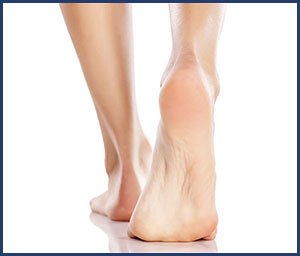
Understanding Laser Therapy for Pain Management
With 26 bones in the foot alone, as well as major ligaments, tendons, joints, and nerves - it’s not surprising that millions of Americans suffer various types of foot and ankle pain.
Class IV laser therapy is used for the relief of pain, to accelerate healing and decrease inflammation.
When the light source is placed against the skin, photons penetrate several centimeters down and are absorbed by the mitochondria (the energy producing part of a cell). This energy results in the restoration of normal cell function.
The main goal of laser therapy is to stimulate the cell to perform its natural functions, but at an enhanced rate.
Laser therapy is a quick and easy treatment allowing patients to relax during the procedure. In contrast to “cold lasers,” which provide no feeling or sensation, high power diode laser therapy provides a warm, soothing feeling.
Some of the most common source of foot pain include:
- Plantar fasciitis - which often creates moderate to severe heel pain
- Tendonitis including
- Achilles tendonitis
- Posterior tendonitis (or PTTD)
- Peroneal tendonitis (tendonitis affecting the midfoot and arch)
- Ankle sprains
- Neuroma (or a pinched nerve)
- Arthritis and inflammation
- Bunions
- Hallux limitus (or a stiff big toe joint)
Any one of these conditions can create chronic (long-term) pain or acute (short-term) pain.



